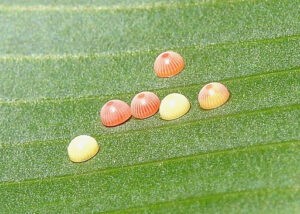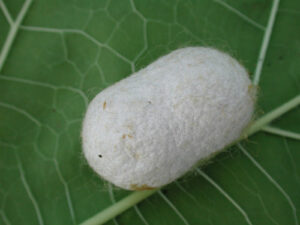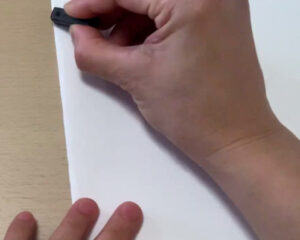
Meet her family below.
Thank you for being here. This post is made up of seven parts.
- Differences among butterflies, moths, and skippers
- Life Cycle
- Small Hands’ Project: “In the midst of leaves”
- Parts of a Butterfly and Vocabularies
- Butterfly Origami
- A Happy and a Sad Story
- Big Hands’ Reads
Rupa’s Family:
Meet the Lepidopterans. There are about 180,000 different kinds of them which are grouped according to their looks and behavior. Generally, their family is represented by the following three species. Can you identify from which one is Rupa?
I

Butterfly
Butterflies have long and thin antennae with bulbs at the end. They are active in the daytime. They hold their wings together when they are resting, just like Rupa on top. Most have colorful vibrant colors.

Moth
Moths generally have pointed and fern like antennae. They are active at night. Their wings are flat when resting. Most of them have drab colors but there are very colorful ones too. They have a “‘frenulum” on their wings

Skipper
Skippers have short or long thin antennae that are bent or hook like at the ends. They are diurnal. When resting, they turn their wings toward the sunlight. They fly in skipping patterns which is the origin of their name.
(please check Vocabularies after “Butterfly Parts” below)
Butterfly image by
Zeynel Cebeci, CC BY-SA 4.0, via Wikimedia Commons
Moth Image by Ian Lindsay from Pixabay
II
Lepidopterans’ Lifecycle:
Metamorphosis is the process of change that occur during the life time of some animals, like the beautiful butterfly.
Everyone started their life as an egg:



Monarch butterfly egg image by Lorie Shaull, CC BY-SA 2.0 via Wikimedia C
Polyphemus moth eggs image by Jacy Lucier, CC BY-SA 4.0 via Wikimedia Commons
Banana skipper eggs image by Dr. Raju Kasambe, CC BY-SA 4.0 , via Wikimedia Commons
They then hatched into very hungry caterpillars:



Monarch caterpillar image by Victor Korniyenko, CC BY-SA 3.0 via Wikimedia Commons
Red-humped caterpillar image by Anthony VanSchoor, CC BY-SA 4.0 via Wikimedia Commons
Mangrove skipper caterpillar by Bob Peterson, CC BY-SA 2.0 via Wikimedia Commons
When they cannot grow any bigger, they will turn into:



Monarch butterfly chrysalis’ image by davidd, CC BY 2.0 via Wikimedia Commons
silkworm cocoon’s image by butterflyarc from Pixabay
Golden Angle chrysalis’ image by Vinayaraj, CC BY-SA 4.0 via Wikimedia
The final stage of their transformation is when they become adults:


Hi! I’m moth

Hi! I’m skipper
Fritillary butterfly’s face image by Laura Åkerblom from Pixabay
Tussar moth’s face image by Yathumon M A, CC BY-SA 4.0, via Wikimedia Commons
Large skipper’s face image by Line Sabroe from Denmark, CC BY 2.0 via Wikimedia
The adults are now ready to have babies, a new life cycle will begin…
III
Let’s try an art project with a glass stained effect. Here, “In the midst of leaves”.
For Mimi by Twin Musicom is licensed under a Creative Commons Attribution 4.0
Step by step:

Your materials:
White drawing paper, black pastel, a pair of scissors and a dry and wet tissue for cleaning up.

Fold your paper
- Fold your paper in half.

Draw
2.Where your fold is, draw a half butterfly.

Identify the parts
3.While you draw, it’s good if you can name the different parts of their body. (Check “Butterfly Parts” below)

Unfold your paper
4.As you unfold, you can see your half-drawn butterfly.

Fold your paper again
5.With the half butterfly in, fold your paper.

Rub the paper
6.With the back of a pair of scissors, rub your paper.

Unfold it again
7.As you unfold the paper, see a whole butterfly.

Trace
8.Make the form clearer by tracing the pattern made from rubbing the paper.

Draw your leaves
9.Draw leaves around the butterfly.

Darken with pastel
10.With a black pastel, darken your pencil drawing of the leaves.

Paint
11.Color your butterfly with any colors you like.

Color the leaves
12.Use a thin brush to color your leaves so the dark pastel marking will not be covered.

Hi Butterfly!
The butterfly project is done.

Cleaning up
Minimize the messy black markings by wiping a dry tissue all over it, and a wet tissue or cloth around your work area.

Another One!
My first project looks a little funny, don’t you think so? I made another one. Do you like it better?
IV
Butterfly Parts

- a pair of antennae – detect smell and wind speed
- they have 6 legs
- compound eyes – the big round eyes help them see on all sides even without moving them
- abdomen – is where their heart and other organs are located
- thorax – their wings and legs are attached here
- proboscis – they uncoil this and is like a straw they use to sip nectar or other liquid
- wing vein -are like tubes that give support to their wings
- eye spots – these can scare off their predators
a butterfly’s profile Image by StockSnap from Pixabay
Here is a closer look of their “straw” or Proboscis

a butterfly’s proboscis Image by DerWeg from Pixabay
Vocabularies:
- Diurnal – animals that are awake or active during the daytime
- Nocturnal – animals that are awake and active during the night
- Frenulum – connects the forewings and hindwings of moths together. They are like bristles or clips that link both wings.
- drab color – dull, light brown
V
Let’s make some Origami Butterflies:

Fast:
Barroom Ballet music by Kevin Macleod
Slow:
VI
A happy story and a sad story:
The Happy Story of a Caterpillar

A caterpillar hatched from a tiny egg, it was so hungry that right away it started to look for food. It ate through different kinds of food, fruits and leaves. It grew longer and fuller until one day it can eat no more and started to change into a chrysalis.
The chrysalis kept still for a while, then it started to move. Slowly, something emerged, a colorful and beautiful butterfly.

Images and synopsis, “The Very Hungry caterpillar” book by Eric Carle.
You can watch a complete metamorphosis “Egg to Monarch Butterfly” from Naturenorth with this page URL: https://www.youtube.com/watch?v=r3J1SZK06mE&t=38s
The Sad Story of a Caterpillar

A caterpillar hatched from a tiny egg, it was so hungry that right away it started to look for food. It was fed and fed the only food it prefers to eat, the mulberry leaves. It grew longer and fuller until one day it can eat no more and started to weave a cocoon around itself.
Silkworm Image by ivabalk from Pixabay
The silkworm Bombyx Mori would have looked like this if it could come out from the cocoon:

Image by P.gibellini, CC0, via Wikimedia Commons
But a silkworm’s cocoon is made up of a single thread from the caterpillar’s saliva. Many people want to get this long thread unbroken and pure to make silk cloths.

Image by Frank Winkler from Pixabay
If the caterpillar turning into a moth can emerge, the cocoon will be ruined. To prevent this, cocoons are baked, steamed, or boiled in water. The pupae inside die.
VII
The Sad Story of a Caterpillar is a true story. Sericulture is the process by which the natural fiber of silk is procured. Silkworm, specifically the “Bombyx Mori”, are raised in order for their caterpillars to spin the cocoon which is made up of filament or silk thread that are harvested to make silk cloth. For thousand of years, these moths have provided human this natural fiber in exchange for their being. They are now blind, cannot fly, have lost their color pigment and are only allowed to mature to give birth. Silk is beautiful, but where they come from is the complete opposite. There are other kinds of silk, the mulberry silk from the ‘Bombyx Mori” is the finest spun by a silkworm.
Big Hands’ Read – Unbelievable Butterflies:
My Butterfly Story
Many years ago while taking a nature drive, I passed by a once famous drive-in cinema which had been abandoned for many years. Curious as to how it might have looked, I drove through the thin forest that covered it. In my head, it could not be so far away and the bushy path would clear up soon as the old theater reveals itself. Enjoying the tranquility of nature, I went inner and farther until I realized that I was looking for something non-existent anymore so I decided to retreat but could not find a clearing.
Getting panicky, I sped-up to find a wider area where I can do a one-eighty when the car stopped moving to a descending terrain. Protruding rocks on the ground caught the tires, stuck! With no phone signal, I could only walk back to where I came from.
I got out of the car and tread back assuring myself that I never made a turn so it could only be a straight direction backward. Dreading somebody or something might be following me made me run on times.
Was I right for two yellow butterflies took my attention and led me to look down, there I saw a band of tiny bluish butterflies fluttering on the left side of my trail, some around my feet. I burst into giggles finding companions from an unbelievable sight. Instantly they solicited a sense of composure. The distress I had earlier just vanished and it felt that their gentle teeny flitting was a gesture saying “don’t be scared, we’re here, just follow”. I thought it was surreal and enjoyed every moment of that walk that finding myself in front of the street where I came from was a disappointment. I looked down again to check them but they were gone.

You might be wondering what happened next. On the side of the road where the butterflies left me, a returning tourist bus with only the driver and a tour guide in it approached and kindly allowed me to hitchhike. Calling a friend who owned a car repair shop was the first thing I did when I could finally use my phone again. We went back in his pick-up after heeding my plea for help and towed the car back to his shop. He checked the underside, no damage had happened.
I never saw such kind of butterflies again. Could the winged creatures be little guardian angels? Perhaps, in the form of butterflies they came to help. Were they figments of my imagination? I’m sure they were real!

